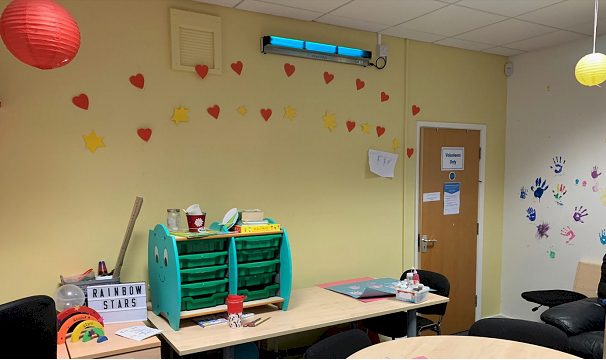
Case Study: Air Disinfection Solutions in a Sensitive Educational Support & Care Setting to prevent and control Covid-19 infection.
Rainbow Stars
Rainbow Stars, Lincolnshire, is a specialist educational group that focuses on supporting the needs of children with Autism, ADHD, Asperger’s Syndrome and other behavioural issues. During the COVID-19 pandemic the registered charity could only welcome a reduced number of children but with such important work, staff and volunteers continued supporting the learning and wellbeing of their most vulnerable children.
With the safety of their volunteers and children being number one priority, when Covid-19 was announced, the staff ensured that everybody entering their space was temperature checked upon arrival, hygiene was significant, and Covid-Secure Guidance followed to the letter.
Nevertheless, Rainbow Stars contacted PP-L in early 2020, not long after the pandemic was announced, to explore options of reducing the risk of COVID-19 and ensure maximum safety of those in their care and in their workplace environment. The Rainbow Stars hub has no mechanical ventilation and only one external wall with small windows. PP-L’s diverse team of Chartered Engineers, Scientists and Medics were early in providing defences for clients in the war against Covid-19 when it emerged strongly in the UK in early 2020, knowing that because coronaviruses are primarily an airborne pathogenic hazard, their experience from the interventions in SARS 2003 with their products and also other ARI’s, they worked on the same basis, that this coronavirus, which causes Covid-19, SARS-CoV-2 was primarily airborne too. Hygiene solutions would be important and easy to implement and so PP-L Biosafety prioritised the infection prevention solution proportionally – 80:20 rule of air purification : surface cleaning effort.

The ventilation in the classrooms was typical of many such older buildings (ventilation limited to small openable windows, no mechanical ventilation) and so, given that back in early 2020, given the lack of suitable, non-VOC emitting and validated portable HEPA Filters (proven since in lab tests (ref.5) at 93% effective against SARS-CoV-2 which is excellent but not as effective as UVC with the 100% of the virus undetectable.), the best course of infection
intervention to protect occupants was to use germicidal UVC upper room filters in both sides of the hub to ensure that the air in the rooms could be disinfected safely.
These Upper Room UVC devices have been used for decades against pathogens and ARI’s and PPL-Biosafety deemed them perfect for this educational setting. Whilst the amount of data available on their successful application in higher risk clinical and laboratory settings is inordinate, Government is currently trailing them in 30 Bradford Schools.
Then, a COVID Case…
All through the pandemic of 2020, with Rainbow Star’s high levels of Covid-secure compliance and more, with the upper room UVC air disinfection filters, the support work at the school continued safely, normally and without incident for the whole of 2020.
At the start of 2021, however, COVID-19 risk was unwittingly brought into the hub by a member of staff who did not have any symptoms, signed-in as feeling healthy & normal, and passed the temperature test to access. What happened next?
Covid is transmitted by people breathing. The exhaled emissions from any individual can result in a major concentration of tiny invisible particles in those breaths (droplets, micro-droplets, aerosol as referred to by the scientists) and within 30-60 minutes in a small confined environment, one person who is infected with COVID in a small poorly ventilated space, just like the charity’s rooms, can infect other occupants who inhale the infected particles, if thorough infection intervention isn’t in place (Source) 1.
The pre-symptomatic volunteer spent the entire day at the Rainbow Stars Hub on 2 February 2021 along with 5 other staff/volunteers, sharing and breathing that same indoors air for most of the day. It was a cold day and the windows were closed. None of the other occupants had at that time been vaccinated, nor had Covid or Covid symptoms previously and so, no disease immunity could reasonably be assumed.
That one staff member felt ill on the next day and tested positive for COVID-19. Upon learning of the positive case, all other individuals who shared the room for the day previous, were instructed to isolate and COVID test.
All five of these other individuals received negative test results for COVID-19, despite the significant risk from spending a whole day in a room with an infectious colleague, which save for the UVC mitigation, would be otherwise, be classified as a poorly ventilated room.
“Receiving five negative tests after close exposure in such a high-risk situation is an amazing feat. It supports the infection protection measures that we put in place and just goes to show the power of how Engineering & Technology solutions can control COVID risks”, said Jane Peck, the Charity’s CEO.
The use of upper room UVC Filters has been scientifically proven as an effective method for combating COVID-19. (Source)2 . As well as this real life incident (averted), recently an independent laboratory tested the efficiency of one of PPL’s solutions against a COVID-19 substitute in a sealed test room which is the average office size. After 7 minutes, the room air containing a surrogate virus to SARS-CoV-2 was disinfected; after 45 minutes:- an 8-LOG (99.999999%) reduction of all the virus in the air was recorded; and after 60 minutes there were no recoverable viable viral particles.
This is sterilisation of the air equivalent to a level equivalent to x10,000 better than most sanitiser hand gels. Clearly in real life settings where a variety of microbes will be present, sterilisation of air is unlikely but if specified correctly, the air can be continuously disinfected with upper room based UVC devices.
What is GUV UVGI?
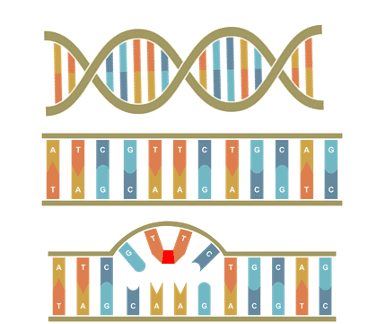 UV-C light is also known as germicidal light as it renders the DNA and RNA of microbes inactive by breaking bonds between the Thymine and Adenine pair and “glues” two adjacent Thymine nucleotides together. This process is irreversible and stops the microbes from undergoing mitosis, inactivating them.
UV-C light is also known as germicidal light as it renders the DNA and RNA of microbes inactive by breaking bonds between the Thymine and Adenine pair and “glues” two adjacent Thymine nucleotides together. This process is irreversible and stops the microbes from undergoing mitosis, inactivating them.
Germicidal UV air disinfection has proven efficacy against the transmission of measles, probably one of the most infectious diseases known to mankind, as well as Tuberculosis, SARS-CoV, SARS-CoV-2 (Covid-19), MERS-CoV,
Influenza A, and “Bird Flu”, as well as many other bacteria and viruses. These have all been successfully inactivated by UV Air Treatment solutions in HVAC and via Upper Room Emitters, both in the labs, and in practical applications over decades. (see our supplementary references document.)
Coronaviruses, are easily inactivated by calculated UVC exposure. (Source) 3 The data from 2004 and 2020, shows how easily Coronavirus is inactivated by UV-C technology. “The survival ability of SARS coronavirus in human specimens and environments seems to be relatively strong. Ventilation and UV irradiation can efficiently eliminate the viral infectivity” (Source) 4
Why choose PP-L?
Our team of Chartered Engineers, Scientists, and Medical experts know your environment and your risks, and we help organizations go beyond government guidance and indeed, beyond Covid-19, to make your operations even safer, infection resilient and more normal, once again for whatever may come in the future. The Engineering & Technologies that we use to prevent and control infection are safe, proven and reliable solutions backed decades of scientific research, engineering, and practical real-world application against all known pathogens.
In fact, we are the only government-listed medical services provider of germicidal UV-C health technology in the UK. We are also an NHS Approved Supplier.
We follow the science to help you protect your people and your business better, both now and for the future.
To see how we can help your workplace, contact us today:
enquiries@ppl-biosafety.com
Bibliography
1. Estimation of Viral Aerosol Emissions from Simulated Individuals With Asymptomatic to Moderate Coronavirus Disease 2019 (https://jamanetwork.com/journals/jamanetworkopen/fullarticle/2768712)
2. Upper-room ultraviolet air disinfection might help to reduce COVID-19 transmission in buildings: a feasibility study (https://www.ncbi.nlm.nih.gov/pmc/articles/PMC7566754/)
3. UV-C irradiation is highly effective in inactivating and inhibiting SARS-CoV-2 replication (https://www.medrxiv.org/content/10.1101/2020.06.05.20123463v2)
4. Environmental factors involved in SARS-CoV-2 transmission: effect and role of indoor environmental quality in the strategy for COVID-19 infection control (https://link.springer.com/article/10.1186/s12199-020-00904-2)
- Removal of SARS-CoV-2 Bioaerosols using Ultraviolet Air Filtration Roy E. Barnewall, DVM PhD1 , Werner E. Bischoff, MD PhD
( https://www.ncbi.nlm.nih.gov/pmc/articles/PMC8007938/ )
For more information on our we help the Education Sector with Air Purification, click here.
The first study was undertaken by Micro-search Laboratories, with the goal of understanding the effect that PP-L’s ultraviolet based germicidal filters will have for these large industrial applications by assessing against a comparable but safe COVID-19 substitute, a similar airborne RNA virus, PHI 6. Tests were undertaken by sampling viral concentrations at several intervals over a 60-minute period. The results were incredible.
Factory environments can present an ideal microbial breading ground, especially in the food sector but now, given the airborne viral hazard that causes Covid-19, even more so. Coronavirus is at optimal infectivity within 5-14 degrees C range which are typical for food manufacture and chilled storage temperature ranges but worse, the air systems in food factories are usually recirculated by the chiller units that are essential to keep the environment cool and food-safe and so, represent the very highest-risk environments for the potential transmission coronavirus in a workplace setting according to statistics
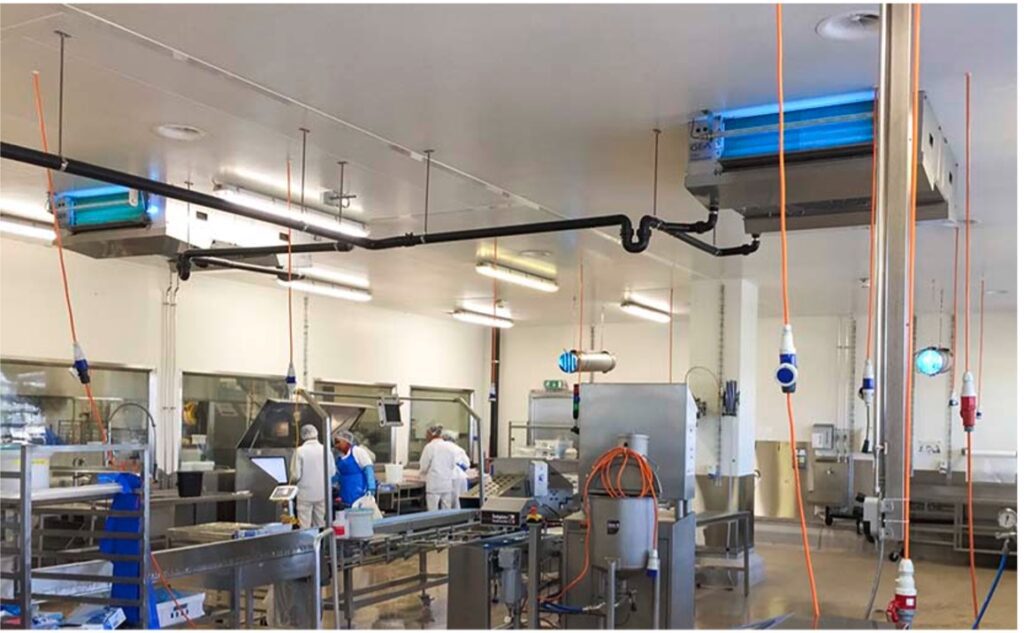
As well the environmental setting, the site in Scotland was also facing the other common problems that the whole food manufacturing sector faces:- the risk of close proximity between staff members working on the lines and also, people shouting over the noise of machinery; shift change-overs create overcrowding; pinch points also can lead to accelerated transmission from the higher viral loads generated.
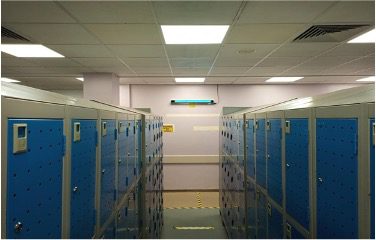
These risks demonstrate the need for engineered infection control solutions to be integrated into workplaces, mitigating the risks that the food and manufacturing sector struggles to avoid by solely following the guidance alone. The risk can be managed and importantly, business operations and production can continue at desired rates, even more safely, almost normally. The HSE general guidance is important but, the risk assessment of the workplace’s such as these, one must inevitably include the need for infection control engineering to mitigate hazards to suit the given environments and operations as are appropriate on a case by case basis.
PP-L’s design process incorporates assessments of specific workplace risk, observing the occupancy within given spaces, understanding potential bio-load concentrations and pinch points. It is also crucially important to model the humidity, temperature, ventilation air flow, filtration, and air distribution within the infection control process. From these parameters, one can identify the ventilation improvements needed inside buildings but importantly for the highest risk environments, it is probable that one must deploy germicidal UV Filters to improve the ventilation because the alternative, supported by the HSE, HEPA Filters, are inappropriate in these settings.
One must calculate the correct UVC dose, select and specify the correct devices and their position, so that one can safely inactivate the target microbes at source but also as part of the holistic primary building HVAC system. Moisture, temperature and air cooling effects must also be considered and in Food Factories, one must recognise the regulations and HACCP issues around glass and food safety. Special tried, tested and proven precautions all need to be considered with respect to UV lamp sepcifications.
PP-L concluded that the engineered infection control solution for the factory in Scotland was the installation of a mixture of different types of active, fan assisted, UVC air disinfection devices to suit the various environmental conditions in the factory, the room sizes, occupancy, viral load, operational and occupational risks. These units were installed by across variety of high-risk areas in the offices, factory, production plant, toilets, locker rooms, and corridors. Even the simplest devices, the upper room UV-C emitters, are a highly effective method for combating COVID-19 (Source) 2
Independent Laboratory Study
Micro-search Laboratories were commissioned by the Client and regulators to investigate the efficiency of specific PPL solutions. The efficiency of deactivating a COVID-19 substitute over a 60-minute period, compared with an independent condition with no UV-C solution present.


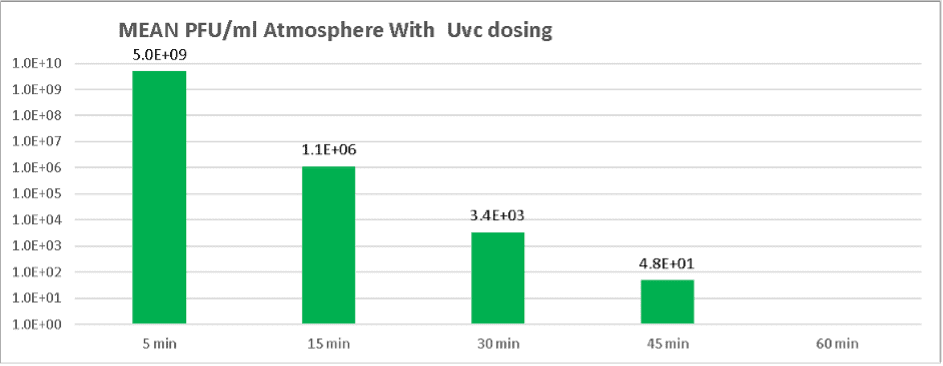
“Our data for stage 1 (no UV-c dosing) indicates that the initial Viral loading after the viral dispersion phase was at the Level of Log 9 plaque forming units per ml of atmosphere.
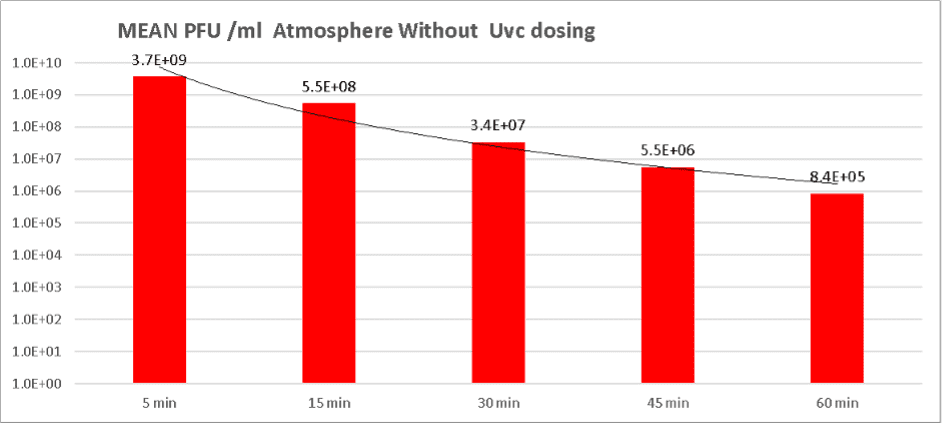
When sampling ended after a total 60 minutes the level had fallen to Log 5 plaque forming units per ml of atmosphere.
Our data therefore indicates that in stage 1 of the trial a 3.6 log reduction of atmospheric levels of viral particles occurred in the absence of UV-c. This is attributable and predictable due to the effect of a variety of physical forces.
With UV-c dosing under similar conditions a much steeper rate of viral non recoverability was observed, with the initial mean challenge level falling from 5.0e9 PFU /ml to 4.8e1 PFU/ml by the 45-minute marker.
We could not recover any viable viral particles at the 60-minute point but the data at the 45-minute mark indicates at least an 8 Log reduction.
This result is > 5 Logs more lethality than was obtained in the same period with no UV-c dosing over the same period. It should be noted that the surrogate organism, the Phi6 phage is a double stranded RNA virus and likely to be 2-3 times more resistant to UV-c than the single stranded COVID 19
No official guidelines currently exist for the magnitude of viral reduction required to render atmospheres as safe so there is no current specific benchmark for Log reduction efficiencies. BS EN standards for other chemical based antimicrobial strategies generally specify a minimum of a 5 Log lethality. Clearly this device delivers performance which exceeds this level of expectation when run for 40 minutes after contamination of the test atmosphere.”
In layman’s terms, rather than the LOG or Lethal Dose terminology, the device’s performance under test in the UK confirms that it can disinfect the air better than most high street hand sanitisers by a factor of times x 10,000 !
Field tests in the factory confirmed performance of PP-L Biosafety’s solutions with statistical results demonstrating p<0.005 and extremely clean air against all the usual microbes commonly measured within the factories.
What is GUV or UVGI?

UV-C light is also known as germicidal light as it renders the DNA and RNA of microbes inactive by breaking bonds between the Thymine and Adenine pair and “glues” two adjacent Thymine nucleotides together. This process is irreversible and stops the microbes from undergoing mitosis and causing harm.
Germicidal UV air disinfection has proven efficacy against the transmission of measles, probably one of the most infectious diseases known to mankind, as well as Tuberculosis, SARS-CoV, SARS-CoV-2 (Covid-19), MERS-CoV, Influenza A, “ Swine Flu” and “Bird Flu”, as well as many other bacteria and viruses. These have all been successfully inactivated by UV Air Treatment solutions in HVAC and via Upper Room
Emitters, both in the labs, and in practical applications over decades. (see our supplementary references document.)
Coronaviruses, are easily inactivated by calculated UVC exposure. (Source) 3 The data from 2004 and 2020, shows how easily Coronavirus is inactivated by UV-C technology. “The
survival ability of SARS coronavirus in human specimens and environments seems to be relatively strong. Ventilation and UV irradiation can efficiently eliminate the viral infectivity” (Source) 4
Why choose PP-L?
Our team of Chartered Engineers, Scientists, and Medical experts know your environment and your risks, and we help organizations go beyond government guidance and indeed, beyond Covid-19, to make your operations even safer, infection resilient and more normal, once again for whatever may come in the future. The Engineering & Technologies that we use to prevent and control infection are safe, proven and reliable solutions backed decades of scientific research, engineering, and practical real-world application against all known pathogens.
In fact, we are the only government-listed medical services provider of germicidal UV-C health technology in the UK. We are also an NHS Approved Supplier.
We follow the science to help you protect your people and your business better, both now and for the future.
To see how we can help your workplace, contact us today:
enquiries@ppl-biosafety.com
Bibliography
- The effect of temperature on persistence of SARS-CoV-2 on common surfaces (https://virologyj.biomedcentral.com/articles/10.1186/s12985-020-01418-7)
2. Upper-room ultraviolet air disinfection might help to reduce COVID-19 transmission in buildings: a feasibility study (https://www.ncbi.nlm.nih.gov/pmc/articles/PMC7566754/)
Why choose PP-L ?
Our team of chartered engineers, scientists, and medical experts know your environment and your risks, and we help organizations like yourselves go beyond the guidance of governments, to make your inside environments extremely COVID-secure. Our hybrid capability enables us to re-engineer infection and significantly reduce the risk. The technologies and tools that we use to improve COVID security are trusted and reliable solutions that build on decades of scientific data, engineering, practical real-world application and experince. In fact, we are the only government-listed medical services provider of germicidal UV-C health technology in the UK, and we always follow the science.
To see how we can help your workplace, contact us today:
0800 471 4871
Bibliography
(1) World Health Organization. Severe Acute Respiratory Syndrome (SARS) https://www.who.int/health-topics/severe-acute-respiratory-syndrome#tab=tab_1.
(2) CDC. SARS https://www.cdc.gov/sars/about/fs-sars.html.
(3) Olsen, S. J.; Chang, H.-L.; Cheung, T. Y.-Y.; Tang, A. F.-Y.; Fisk, T. L.; Ooi, S. P.-L.; Kuo, H.-W.; Jiang, D. D.-S.; Chen, K.-T.; Lando, J.; Hsu, K.-H.; Chen, T.-J.; Dowell, S. F. Transmission of the Severe Acute Respiratory Syndrome on Aircraft. New England Journal of Medicine 2003, 349 (25), 2416–2422. https://doi.org/10.1056/nejmoa031349.
(4) HO, P.-L.; TANG, X.-P.; SETO, W.-H. SARS: Hospital Infection Control and Admission Strategies. Respirology 2003, 8 (s1), S41–S45. https://doi.org/10.1046/j.1440-1843.2003.00523.x.
(5) Wong, T.; Wallington, T.; McDonald, L. C.; Abbas, Z.; Christian, M.; Low, D. E.; Gravel, D.; Ofner, M.; Mederski, B.; Berger, L.; Hansen, L.; Harrison, C.; King, A.; Yaffe, B.; Tam, T. Late Recognition of SARS in Nosocomial Outbreak, Toronto. Emerging Infectious Diseases 2005, 11 (2), 322–325. https://doi.org/10.3201/eid1102.040607.
(6) Darnell, M. E. R.; Subbarao, K.; Feinstone, S. M.; Taylor, D. R. Inactivation of the Coronavirus That Induces Severe Acute Respiratory Syndrome, SARS-CoV. Journal of Virological Methods 2004, 121 (1), 85–91. https://doi.org/10.1016/j.jviromet.2004.06.006.
(7) Duan, S.-M.; Zhao, X.-S.; Wen, R.-F.; Huang, J.-J.; Pi, G.-H.; Zhang, S.-X.; Han, J.; Bi, S.-L.; Ruan, L.; Dong, X.-P.; SARS Research Team. Stability of SARS Coronavirus in Human Specimens and Environment and Its Sensitivity to Heating and UV Irradiation. Biomedical and environmental sciences: BES 2003, 16 (3), 246–255.

Leave a Reply